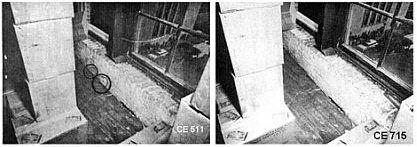

Without the evidence found on the sixth floor of the Texas School Book Depository, there is no physical evidence tying Lee Harvey Oswald to the assassination of President Kennedy. But the evidence, discovered by the Dallas Police Department within an hour of the assassination, was photographed in place by Lieutenant Day and Detective Studebaker before it was touched. Or was it???
We know that no photograph exists of the paper sack discovered in the sniper's nest. But what about the photographs Day and Studebaker took of the three spent shells in the sniper's nest???
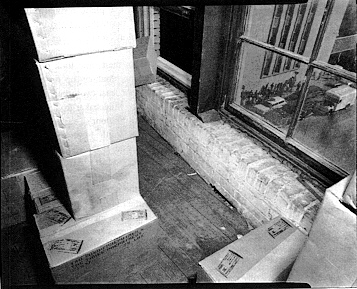 Notice the far window
in the two exhibits (above) and the Studebaker photo (right).
Notice that it is completely black, showing absolutely no detail.
Compare that with the other window, which clearly shows a daylight
scene showing the crowd and traffic in front of the County Records
Building.
Notice the far window
in the two exhibits (above) and the Studebaker photo (right).
Notice that it is completely black, showing absolutely no detail.
Compare that with the other window, which clearly shows a daylight
scene showing the crowd and traffic in front of the County Records
Building.
Keep in mind that these photos were allegedly taken at approximately 1:00 PM on the afternoon of the assassination. How can you have possibly have a daylight scene in one window, while the other window shows darkness consistent with midnight rather than mid-day??? We should be able to see the north face of the light colored County Records Building through that window. I believe these photos were taken at a later time, and that they were altered to hide the fact they were taken during the night. The daylight scene we see through the near window was added to the photos to make it appear that they were taken in the afternoon.
The photo on the left shows the same area taken from the opposite direction. Notice the corner of the near window (white rectangle). It shows the same absolute blackness as the other photos. I include this to dispel any notion that the extreme darkness seen through the window was caused by a shadow on the north face of the Records building. The photo on the right was taken by a newsman on the afternoon of the assassination, and shows just how much sunlight filtered through those windows.
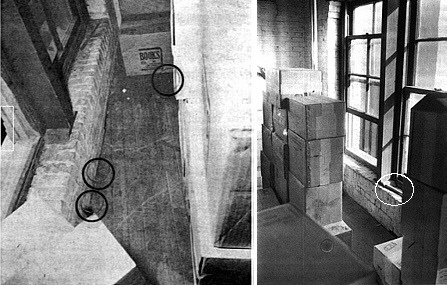
There are more indications that Dallas Police Department's sniper's nest photos were not taken the afternoon of the assassination. Notice the object on the window ledge in the photo top right (see circle). This appears in several of the photos taken by newsmen that afternoon after Day & Studebaker took their evidence photos. Closer examination of these photos reveal that the item is a hammer.

Since this hammer does not appear in the official DPD photos of the sniper's nest, we must conclude that Day and Studebaker took their photos after the hammer had been removed from the scene. Since we know that the hammer was there when the press took their photos around 3:00 PM that afternoon, the crime scene photos had to be taken after that time.
One thing to keep in mind is that several of the warehouse workers were putting down a plywood floor on the sixth floor on the day of the assassination. But Oswald was not one of them, so we wouldn't expect him to be carrying a hammer. Finding a hammer in the sniper's nest strongly suggests that one of the other warehouse workers was in the sniper's nest after 11:45 PM when they broke for lunch.
Former WFAA newsman Tom Alyea entered the Texas School Book Depository before it was sealed off, and was the only newsman on the scene as the Dallas Police searched the building. Alyea has stated:
The barricade on the sixth floor ran parallel to the windows extending in an "L" shape that ended against the front wall between the first and second twin windows. The height of the stack of boxes was a minimum of 5 ft. I Looked over the barricade and saw three shell casings laying on the floor in front of the second window in the two window casement. They were scattered in an area that could be covered by a bushel basket. They were located about half way between the inside of the barricade and the low brick wall under the windows. No shell casings were touching the wall or the inside of the barricade. I set my lens focus at the estimated distance from the camera to the floor and held the camera over the top of the barricade and filmed them before anybody went into the enclosure. I could not position my eye to the camera's view finder to get the shot. After filming the casings with my wide angle lens, from a height of 5 ft., I asked Captain Fritz, who was standing at my side, if I could go behind the barricade and get a close-up shot of the casings. He told me that it would be better if I got my shots from outside the barricade. He then rounded the pile of boxes and entered the enclosure. This was the first time anybody walked between the barricade and the windows.
Fritz then walked to the casings, picked them up and held them in his hand over the top of the boxes for me to get a close-up shot of the evidence. I filmed about eight seconds of a close-up shot of the shell casings in Captain Fritz's hand. I stopped filming, and thanked him. I do not recall if he placed them in his pocket or returned them back to the floor, because I was preoccupied with recording other views of the crime scene. I have been asked many times if I thought it was peculiar that the Captain of Homicide picked up evidence with his hands. Actually, that was the first thought that came to me when he did it, but I rationalized that he was the homicide expert and no prints could be taken from spent shell casings. Therefore, any photograph of shell casings taken after this, is staged and not correct. It is highly doubtful that the shell casings that appear in Dallas police photos of the crime scene are the same casings that were found originally. The originals by this time were probably in a plastic bag at police headquarters. Why? Probably this was a missing link in the report the police department had to send to the FBI and they had to stage it and the barricade box placement to complete their report and photo records.
Secrets from the Sixth Floor Window by Connie Kritzberg
While I agree with Mr. Aylea that the sniper's nest photos were staged sometime after the fact, I doubt that it was simply to "...complete their report and photo records." We know that Day and Studebaker took photos on the sixth floor Friday afternoon. The only reason to retake those photos was to change the content in order to fit the case against Oswald. There is no acceptable reason to fake evidence photos, and any such photos must be discarded as evidence. Period.
Did the Dallas Police have the opportunity to stage these crucial crime scene photos after-the-fact??? Obviously, the photographs in question couldn't have been taken later in the evening if the Dallas Police Department did not have access to the building. Detective Studebaker testified, "I was up in that building until 1 o'clock that morning..." Referring to the Book Depository, Lieutenant Day told researcher Gary Savage, "I had a key to it..." First Day Evidence, pg.182.
Lieutenant Day told the Warren Commission that they took several reconstruction photos on Monday, November 25th. Among the photos, were Commission Exhibits 733 and 734:
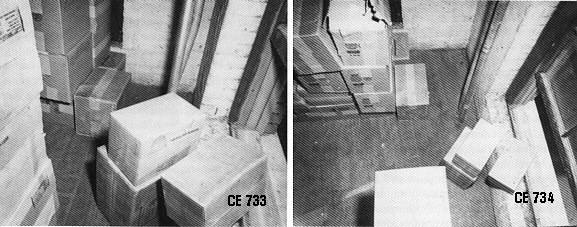
Although Day told the Commission that one photograph was taken Monday morning (CE 727). But these two photos were obviously not taken in the morning, for once again we see the black of night through the window. Here's another photo taken at that session:

These photos prove beyond any doubt that someone from the Dallas Police Department was on the sixth floor of the Depository taking photos of the sniper's nest in the dead of night. And the pitch black window seen in the photos of the three shells betray the fact that those photos were taken during this middle of the night photo shoot, and not on the afternoon of the assassination as claimed.
New Evidence

In July 2003, John McAdams offered the above photo as evidence that I was wrong because you can see detail in this overexposed print. Since I never claimed that the window was blacked out by DPD as McAdams thought (my claim was that the photo was taken at night), that is pure nonsense.

In fact, this photo proves alteration. If you look at the lines I added, the windows on the light side of the building are not parallel to the windows on the dark side. This can be further demonstrated by vanishing point analysis. All parallel lines in a photo must converge at the same point.
If you look at the vanishing point analysis (right), you will note that the lines in the dark window all converge at the same point as they should (marked A but hard to see). The other windows also converge at the same point (B), but not point A. Since all those windows are parallel, they must converge at the same point, and the fact that they don't proves that this photo is a forgery.
I do apologize for the lack of quality, but I had to compromise to keep it a reasonable size. The presentation is about three feet long, so I couldn't scan it. I took a digital photo of it, and reduced it to a point where it reasonably sized and at the same time, clear enough to get the idea across.
On a different subject, I thought I would add one more item while I was updating this page. The photo below shows the box where Oswald's palm print was allegedly found. Detective Studebaker discussed the taking of the picture during his Warren Commission testimony:
Mr. STUDEBAKER. As soon as the print was lifted,
you see, I taped it and then they took the print down there. They just took the
top corner of this box down there.
Mr. BALL. They just took the top part of the box down there?
Mr. STUDEBAKER. Yes, and when we took this picture, we took it back--that staff
has been up there and back until I was so confused I don't know what was going
on.
Mr. BALL. You mean, when you took the picture which is marked Exhibit J----
Mr. STUDEBAKER. This picture has the palm print on it.
Mr. BALL. It has the palm print--it had been removed and had been identified and
brought back and put in the box?
Mr. STUDEBAKER. It had been brought back and put in the box and as being
Oswald's right palm print.
Mr. BALL. So, in Exhibit J, you put the cardboard back on the box?
Mr. STUDEBAKER. On the box, yes, sir; where it was found.
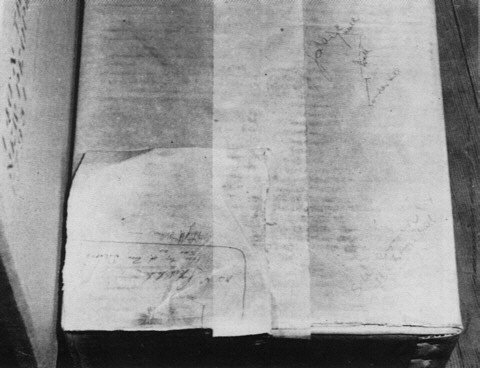
This does not seem to be the box that corner came from. It appears undisturbed, no rips or tears. The box corner is just sitting on top of it. If so, where is the box that LHO's palm print was found???
Jerry McLeer
April 16, 2000
Updated July 11, 2003
Return Home